Asian cuisine is often touted as too complicated or tiresome to cook.
To begin with, there is usually an array of dishes, each of which will have several components that have to be cleaned, cut, and cooked in different ways.
On top of that, the numerous spices employed in Asian cooking that help bring out a multiplicity of flavours in each dish must be gathered and then pounded or blended into a paste.
Making a meal even for two can take the better part of a day.
The same holds true for Singaporean food.
For instance, the spicy-sweet mouthwatering rendang (a meat dish) employs 13 different spices.
Local favourites like wanton mee (dumpling noodle soup) become troublesome to make at home as the char siew (barbecued pork), dumplings and sauce must first be made before one can even think about assembling a plate so easily accessible at a hawker centre.
Cooking local cuisine when overseas is even more challenging if the crucial spices and ingredients have limited availability.
Singapore students living overseas or who are on exchange choose instead to take on alternative Western dishes with readily bought ingredients and forgo a taste of home for convenience's sake.
However, with a few simple tweaks and cooking hacks, easy local recipes can be recreated and provide students the home-cooked goodness they crave.
A few Singaporean foodies share their tried and tested recipes that they whip up when overseas.
Globetrotter's comfort food is claypot rice
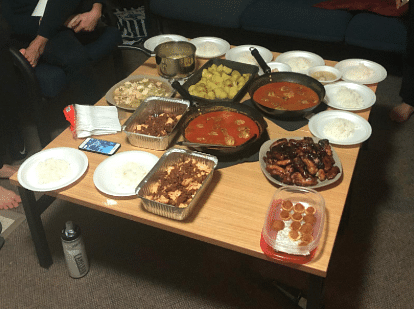
While on exchange in Ontario, Canada, Gerald Sim and his fellow exchange students were in their dorm contemplating what dish to make for dinner , when they stumbled upon on the ultimate comfort food: claypot rice.
"We figured that this dish is so versatile and easy to make, we actually threw in some leftovers from lunch to add some local flavour to it.
"I think this is a good one-pot meal for any student who wants a hearty meal to share with the roomies, with little washing up to do after," said Mr Sim, 24.
Starting his overseas journey with three friends Mr Sim, currently in Nanyang Technological University, now has a close group of 12 Singaporean friends that he met on his exchange programme of five months at the University of Waterloo.
While they began cooking daily due to the high costs of school food, the group held "pot-luck dinners" on special occasions. with each member contributing a dish.
"On Chinese New Year we each brought something different. There was baked chicken, Mapo tofu, curry chicken, Chinese leek, pineapple tarts and soup. We even made lo hei (a Chinese New Year salad that is tossed for luck). Everything was homemade and from scratch," he said.
Aside from becoming a proficient cook, Mr Sim has clocked about 8,000km of driving on numerous road trips, ridden on a snowmobile through minus 25 deg C glaciers and hiked up Yosemite Falls, the highest waterfall in Yosemite National Park.
"After my friends leave for Singapore, I'll be mountain biking in Whistler, Vancouver, and white-water rafting down the Ottawa river, so my adventure will continue then," he told The Straits Times in April.
Despite his travels across the United States, he said like all Singaporeans, he missed Singapore's cheap hawker food and would definitely be heading for a hearty bowl of bak chor mee the moment he arrived home in Singapore at the end of May.

Comfort-food Claypot Rice (30-40 min cooking time, serves 4)
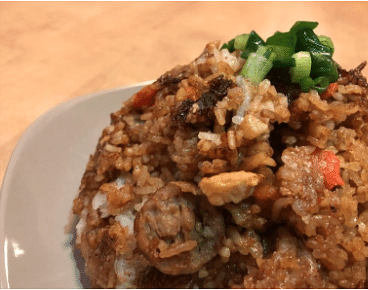
Ingredients:
- 250g skinless boneless chicken breast or thigh
- 3 Chinese sausages (If Chinese sausage is unavailable, honey garlic or sweeter sausages are good alternatives)
- 1 piece ginger, crushed (an index finger's length)
- 4 cloves of garlic
- 3 cups of rice (about 400g)
- 1.5 tablespoons of cooking wine
- 2 tablespoons of light soy sauce
- 1 tablespoon of sesame oil
- 200ml chicken stock
- 2 tablespoons of dark soy sauce
- cabbage leaves (500g)
- 1 carrot
Optional:
Spring onion for garnish
6 dried shiitake mushrooms (soaked in warm water for 15 minutes, drained and sliced)
Equipment:
Frying pan, rice cooker
Method:
1. Cut chicken breast into bite sized pieces, add crushed ginger, soy sauce and cooking wine and leave to marinate for 10 minutes to an hour.
2. Wash the rice and place in the rice cooker with 2 cups of water and 200ml of chicken stock. Add the sesame oil for fragrance (a pinch of salt can be added but that is optional).
Tip: Since we used 3 cups of rice, we put 2 cups of water and 200ml of chicken stock to cook. The water to rice ratio should be: 1:1.
3. Dice the garlic and carrots. Slice the cabbage into thin strips and the Chinese sausage into thin slices.
4. Heat 2 tablespoons of oil in a pan and sauté the garlic until golden, then add the sliced Chinese sausage and fry until the slices turn a light brown. If you have mushrooms, this is a good time to throw them in too.
5. Add the diced carrots and sliced cabbage, and half a cup of water. Cover and allow water to be absorbed. Stir occasionally.
6. When the liquid in the pan has been reduced, pour everything from the frying pan into the rice cooker (where the rice should be done cooking by now). Add dark sauce and stir everything. Add light or dark soy sauce for more taste if you want. Leave for about 10 min before serving.
7. Serve with spring onions as garnish
SAF pilot digs Bak-kwa
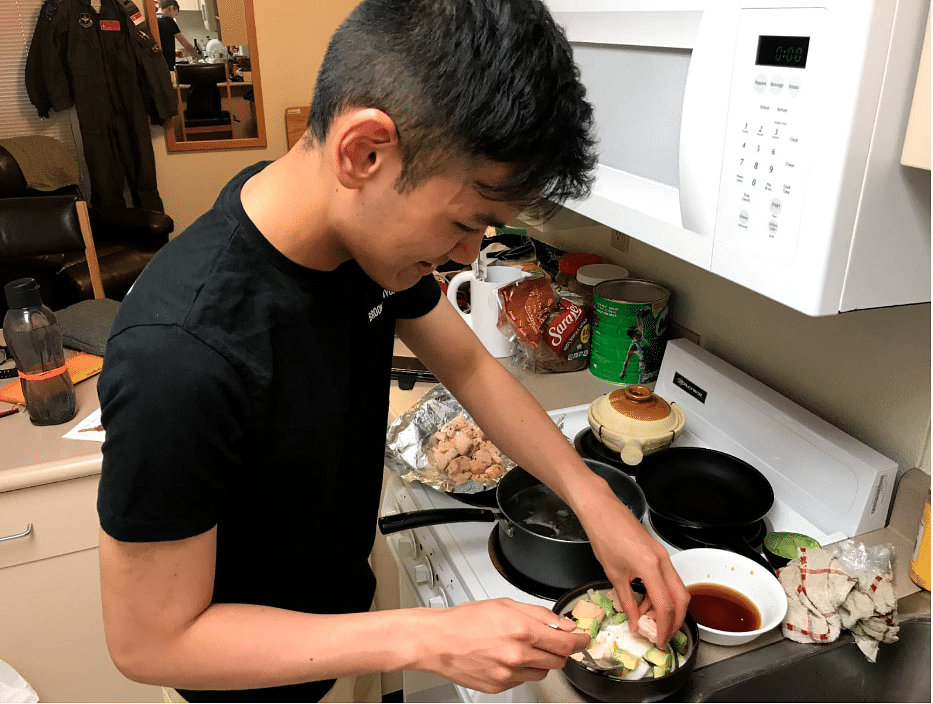
As a self-proclaimed foodie, locating "cheap and good" food proved to be a huge challenge for Mr Kennedy Wong when he moved to Enid, Oklahoma, for an overseas training course with the United States Air Force in 2017.
-
List of essential ingredients to load up on when in Singapore
-
Prima Curry and satay premix packets
Prima laksa instant noodles
Garlic chilli sauce and sambal chilli packets
Chicken rice and tom yum premix
Bak kut keh spice packets
Miso paste
5 spice powder
"It's almost impossible to recreate the prawn-pork broth that is so easily bought at Singaporean hawker centres," he lamented. "That would be the hardest challenge apart from of course, missing family and friends."
A trainee pilot with the Republic of Singapore Air Force (RSAF), Mr Wong stayed for one year and two months at Vance Airforce base in Enid, before moving to San Antonio, Texas, to complete the second part of his course.
The initial move was not easy as he faced difficulties in finding Asian food while in Enid.
"In Oklahoma, the air base I was at was an hour's drive from the city, which is where most of the Asian food was. That's why I decided to cook," he said.
Boredom was another factor that inspired him to cook, as he was on his own for the first six months.
"After training you don't have anything to do in the evening. You don't feel like going out to eat junk food so you cook at home. It's cheaper too," he said.
Things got better when he was joined by another RSAF trainee, who relieved him of the boredom of solo drives into the city, as well as joined him in the kitchen.
Bak kwa is Mr Wong's favourite that he learnt to make. But he tried other dishes too.
"I even made chicken rice for him during his birthday," he said.
The 22-year-old states that his time abroad allowed him to master his signature dish, a simple Japanese rice dish named oyako-don, that he has made more than 10 times and takes five minutes to whip up.
His trick to making easy homemade bak kwa?
"Use fatty minced pork. Many times, recipes from Google are different from each other, so you can just combine the different ingredients for the marinade and experiment with the taste."
Easy-Breezy Bak Kwa (50 min cooking time, serves 4)
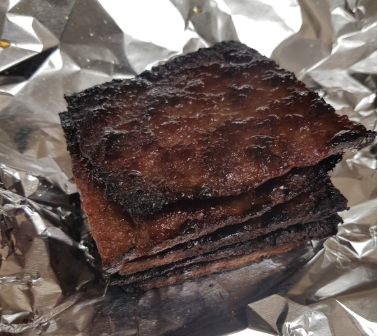
Ingredients:
- 500 g pork (choose pork with a bit of fat)
- 1 tbsp soy sauce
- 1 tbsp fish sauce (can be substituted with an additional tbsp of soy sauce)
- 1 tbsp sweet soy sauce (kecap manis) (can be substituted with 1 tbsp of sugar)
- 0.5 tbsp oyster sauce
- 1.5 tbsp honey
- 80g sugar
- 0.25 tbsp salt
- 0.25 tbsp pepper
- 0.25 tbsp five spice powder (optional)
- 1 tbsp rose wine (or shaoxing wine) (optional)
- 1 tsp water
- 1 cube fermented red tofu (this can be omitted as its main purpose is to give the bak kwa its bright red colour)
Equipment:
Oven, 15 x 10 inch pan, rolling pin, parchment paper/baking paper/aluminium foil
Method:
1. Mix the soy sauce, fish sauce, sweet soy sauce, salt, pepper, five spice powder (optional), rose wine (optional), red tofu (optional), oyster sauce and sugar with the minced meat. Mix until a sticky and pasty texture is formed.
2. Preheat your oven to 120 deg C. Line the pan with parchment paper (or baking paper / aluminium foil) and transfer the marinated pork to the lined pan. Flatten the pork on the pan with a rolling pin until the meat evenly covers the pan.
Tip: The rolled meat should be about 3mm in thickness, not too thin but not too thick.
3. Bake for 15 minutes. Remove the tray from the oven, gently loosen the meat with a spatula and turn it over. Bake again for another 15 minutes and remove from the oven.
4. Cut the half-baked bak kwa into the desired size (4 x 4 inch squares are preferable) and transfer to a new piece of parchment paper. Brush the top of the meat with honey and a bit of hot water.
Tip: You can sprinkle some sesame seeds or other toppings on the bak kwa at this point if you prefer.
5. Increase the oven's temperature to 190 deg C and return the pan to the oven. Bake the bak kwa for another 5 to 10 minutes. Take out the pan from the oven, turn over the meat and brush the other side with honey and a bit of hot water. After that bake again for 5 to 10 minutes.
6. Take out the bak kwa and allow to cool. And there you are, some bak kwa to enjoy during a festive season out of Singapore. Huat ah!
Business analyst's cheat sheet to dry bak chor mee

When asked to introduce her homemade re-creation of the iconic Singaporean dish, bak chor mee, Ms Jane Wong explained, "This is a cheat's guide to dry bak chor mee. Shortcuts will be taken but you will have a close-enough-to-bak-chor-mee tasting dish in about 20 minutes."
Currently a business analyst at the Royal Bank of Scotland (RBS) in Edinburgh, the 24-year-old has been experimenting with home cooking for four years.
She began cooking for herself when she moved to the University of Exeter, Devon, in 2015 and like most students overseas, found it too costly to eat out.
After graduating with a Bachelor's in Business Economics, Miss Wong secured a job at RBS, where she now works as a business analyst.
In her free time, she enjoys whipping up local delights such as nasi lemak, chicken rice and chicken curry, to share with her international flatmates as well as Singaporean friends:
"It's fun because you get to introduce people to new food, but at the same time, give Singaporeans a familiar taste of home."
There is, however, still something she hankers for.
"I miss char kway teow because it's not really something you can cook on your own. If you're in London you can find it, but it's still missing something."
She also misses char siew rice (barbecued pork rice), a favourite of hers that she has yet to recreate successfully and enjoys on her annual trip home.
The "Close Enough" Bak Chor Mee (25 - 30 min cooking time, serves 1)
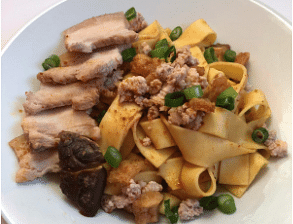
Ingredients:
Toppings
- 75 grams of minced pork (feel free to use other meat)
- ½ dried shiitake mushroom (soaked)
- 5 pieces of pork scratchings/rind snack (Used to replace the crispy lard pieces. Alternatively, make your own lard pieces by simmering some cubed pork fatback in a tiny bit of water with salt and sugar until rendered
- 3 meat balls/ fish balls (can be purchased ready made from store)
- Chopped spring onions (optional)
- Fried shallots (optional)
- Fried garlic slice (optional)
- Pinch of white pepper (optional)
Sauce
- 2 tsp chinese black vinegar
- 1 tsp chilli paste/oil of any brand(chilli paste can be substituted with nasi lemak sambal or a chinese chilli oil such as lao gan ma)
- 2 tsp light soy sauce
- 1 tsp oyster sauce (can be substituted with more soy sauce)
- 1 tsp any type of oil (preferably lard if you have it on hand)
- A few drops of fish sauce (optional)
- Sprinkle of any type of chilli flakes (optional)
Noodles
- 80 grams flat fresh pasta noodles (tagliatelle is a good type to use)
Tip: Can be substituted with 1 pack of instant noodles or ramen noodles. However, stay away from dried pasta.
Equipment:
Serving bowl, pot, mug, sieve
Method:
1. In a pot, boil 3 cups of water.
2. While waiting, break 3 of the pork scratchings into about 1 cm pieces. Place the small pieces of pork scratchings and the dried shiitake mushroom into a mug.
Tip:If you are using actual pork belly, do not soak it and just soak the mushrooms instead. If you are not using pork scratching and dried mushrooms, skip the next step.
3. When the water is boiled, add 4-5 tbsps of the boiling hot water into the mug. Ensure that everything is submerged in the water. Set aside and leave to rehydrate for 20 minutes.
4. Mix all the ingredients for the sauce into a serving bowl.
5. Season the minced meat with 1 tsp of light soy sauce and a pinch of white pepper (optional). Cook in the boiling water. Remove with a sieve once cooked. Set aside.
6. The pork scratchings and mushrooms should have become rehydrated and become soft. Add that (including any remaining liquid) into the bowl with the sauce.
7. Cook the noodles in the same pot of water until done and drain, saving some cooking water. Place the noodles into the same bowl as the sauce mixture and toss.
Tip: If you find the noodles are a little dry, add some of the water you saved.
8. Finally, add all your toppings, including the remaining pork scratchings/pork belly and enjoy!
Making chicken curry in Rotterdam

Ms Dinah Seng is no stranger to cooking.
Previously introduced to the world of fine dining by a close friend when she was 17, the 24-year-old learnt that with extensive research and an eye for good deals, it was very possible to eat well while maintaining a tight budget.
This lesson was put to the test when she embarked on a seven month exchange trip in Netherlands, at Erasmus University Rotterdam.
"Everything was so expensive, so I cooked almost three meals every single day, sometimes four," she said.
However, cooking overseas proved to be an exciting challenge for Miss Seng as she had the liberty to choose her own fresh produce at local farmers' markets, as well as throw together a hearty meal based on the freshest ingredients available.
Besides accessing fresh market produce, she was able to hone new culinary skills.
"I am definitely more competent in choosing fresh vegetables and telling them apart," she explained.
"Now, I am able to tell the different herbs apart as well as how to properly store these herbs and keep them as fresh as possible."
She also joined the swarms of Dutch cyclists and bought her own bicycle to travel around Rotterdam's many cycle-paths:
"The ability to get around everywhere with a bicycle is extremely liberating. It's like having your own car and being able to take yourself anywhere you wanna go. That little bicycle really played a huge part in my exchange and the sights along the way were beautiful as well."
While Miss Seng is happy to be home, she is actively searching for opportunities to work overseas and is once again looking forward to experimenting with different cuisines in the kitchen.
Convenient Curry and Kailan (Chinese Broccoli) (30 - 45 min cooking time, serves 4)
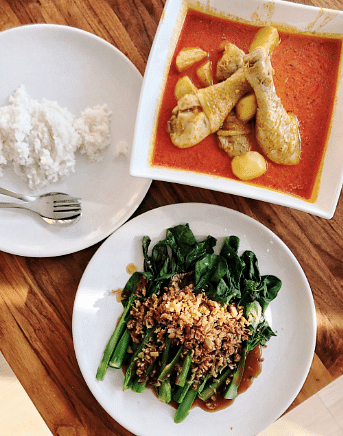
Part 1: Chicken Curry
Ingredients
- 8 chicken drumsticks (or any part of the chicken available to you)
- 4 potatoes, peeled and cut into quarters (add more if you love potatoes like me)
- 4 shallots peeled and sliced thinly
- Prima Taste Singapore Chicken curry packet
Tip: Don't pack it in your luggage with the box, take out the sachets to save space. - Long beans (optional)
Method
1. Marinade your chicken drumsticks in the curry paste. Rub it in and leave it covered for at least 2 hours.
2. Dice up potatoes, fry them in shallow oil till they're slightly brown on the outside. Remove and put aside (to be used later)
3. With the remaining oil, fry up your shallots and then add in chicken that's been marinated with the curry paste.
4. Stir fry for 2-3 minutes until fragrant, add in the potatoes, mix it until the paste coats it.
Tip: At this point, if you like your curry spicier, add in a tbsp of chilli powder. The premix is usually not too spicy.
5. Add in the coconut milk (follow instructions on packet)
6. Bring to the boil then simmer uncovered until the meat is cooked (20-30 min).
Part 2: Kailan with oyster sauce and crispy shallots
Ingredients:
- 2 bunches of kailan
- 1 tbsp of cornflour
- 4 tbsp water
- 4 tbsp oyster sauce
- 1/2 tbsp of sesame oil
- crispy shallots (store-bought or fry your own in shallow oil)
Method:
1. Cut the kailan stems in half lengthways. Rinse well.
2. Cook the kailan in a large saucepan of boiling water for 2-3 minutes or until bright green and tender crisp. Refresh under cold running water. Drain. Transfer to a serving plate.
Tip: Alternatively, put kailan in a shallow bowl, cover with microwaveable cling wrap. Microwave on high for 2 mins first and then in 30 second bursts until desired tenderness. Be careful of the rush of scalding steam when you're removing the cling film.
3. Stack kailan on a plate while you prepare your sauce.
4. Combine cold water, cornflour in a small pot. Mix to dissolve. Add oyster sauce and sesame oil. When sauce thickens, about 30 sec later, drizzle over your veggies.
5. Stir fry minced garlic and thinly sliced ginger with some oil, before adding in oyster sauce, sesame oil and the water cornflour mixture.
6. Top with crispy shallots

